I have moved my blog to my own domain which is www.drbirute.com. Please go directly to that site to read any future blog postings. I will no longer be posting at WordPress.com.

Fire roars across landscape in eastern part of Tanjung Puting National Park
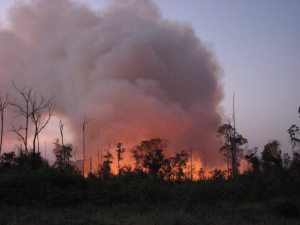


OFI rangers fighting fire on eastern side of Tanjung Puting National Park

Please note that all photos are copyright OFI.
They say that a photo is worth a thousand words. Here is the equivalent of a few thousand words: photos of the fires that OFI is facing and fighting in 2009. The extreme droughts that enable human-made fires to blaze throughout Kalimantan (Indonesian Borneo) and Sumatra seem to be much more frequent than they ever used to be. The last El Nino was in 2006 when over 50 of our OFI assistants fought the fires for almost two months before the fires were brought to a stop.
Some scientists believe that the increasing frequency of El Nino years is related to global climate change. Having lived in Borneo for several decades I suspect that this belief is true.
The eastern part of Tanjung Puting National Park, which is directly next to palm oil plantations, burned in 2006, making it particularly vulnerable to fire again in 2009. It is in this critical area of double jeoparty that the above photos of OFI rangers fighting the fires were taken. Once forest is repeatedly burned, secondary succession is deflected and it is very difficult for the tropical rain forest to return.
At least one thousand of the six thousand wild orangutans in Tanjung Puting National Park and its vicinity live on the eastern side of the Park where the fires are currently burning. It is crucial that these fires be stopped for the sake of wild orangutan populations and all wildlife in the area. OFI is doing all it can to make this happen but we need help and funding.
Posted in 1 | 4 Comments »
Please take a look at the map in the previous post! You will see that only one post on the boundary on the eastern side of the Park is threatened by fire. Our guardposts are the little blue figures while the red spots need no explanation. Those are the fires burning at the end of August 2009.
The fire near our guard post is on the verge of being eliminated. Notice that the fires burn where we do not have guardposts. Coincidence? I don’t think so.
The map tells the story. Words are not that necessary.
Posted in 1 | 10 Comments »

Hot spots in and around the vicinity of Tanjung Puting Park as of the end of August 2009
The Park is ablaze but not where the tourists go. They may smell the smoke and see the haze in the sky but Camp Leakey and the forests around it remain untouched because we are there and have been for 38 years. It is where the farmers work and where the enclaved villages are located within the Park that the fires burn out of control. It is also on the Park boundaries next to the palm oil plantations that the worst fires burn.
In 2006 during the last El Nino year OFI and its partners battled fires that ultimately destroyed about 15% of Tanjung Puting National Park. We are now trying to prevent the same. We are fighting the fires shoulder to shoulder with our partners in the Forestry Department and we need all the support that we can get.
Posted in 1 | Leave a Comment »
I haven’t blogged for over a month, but goodness knows, I have tried. Being in the field all this time in Kalimantan made it virtually impossible to have internet connections. Putative swine flu felled three of the volunteers on the first OFI team at the end of July and they were quarantined for 10 days by the Indonesian health department. This brought on its own problems, problems we had never encountered before. Everyone emerged from the experience healthier than ever and swine flu was never actually proved.
There were also visitors galore, many most welcome and a pleasure to see but still it kept me hopping. And, of course, the orangutans! They keep us busy nonstop, night and day, it seems.
I am now in Jakarta and will attempt to blog again. Please forgive me but the forests of Indonesian Borneo, where I do my work, seem to be more accessible by palm oil concessionaires, fires, and illegal loggers than by internet.
Posted in 1 | 10 Comments »
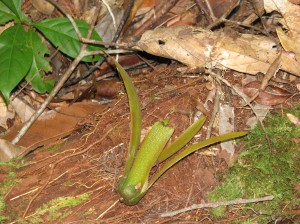
A dipterocarp seed on the ground in the newly bought forest

Mr. Freddy and Dayak village elder Mr. Ijai on forest land bought by OFI
Mr. Freddy is a local businessperson from whom OFI recently bought 20 hectares of forest land. He has nothing to do with my son Fred who is called Freddie by some of his friends.
Upon my return to Kalimantan (Indonesian Borneo), the first thing I did was check, once again, the 20 hectares of forest OFI had bought from Mr. Freddy. A small part of the 20 hectares consists of an open field with some of the tallest coconut trees I have ever seen, perhaps 50 feet tall.
The boundary of the purchased forest is in tropical peat swamp forest with some large trees, including dipterocarps, found within. The rest of the forest consists of dry ground forest. There is a footpath which makes walking through the forest a treat. As we walked there, the sun was shining and the sky was blue. There were virtually no mosquitoes, despite the presence of the swamp forest nearby.
At the end of our walk, everyone was thirsty. I had run out of water as I had brought a very small container, only half full of water. I hadn’t realized that we would be walking the forest boundary which was still ankle deep and occasionally knee-deep in water. The forest floor was soggy mud. Only at the height of the dry season does the swamp turn into solid ground. In mid-July we are still a few weeks away.
It was a hard walk. I was wearing my black Crocs, very much showing their wear and tear after three years of non-stop use. The swamp water conveniently poured out of the decorative holes in my Crocs but the age of the shoes also meant my feet had no traction and no real support as I slipped and slid on the smooth roots of trees and in the mud.
When we finally got to the clearing I was relieved. I asked if any of the young Dayak assistants could climb one of the coconut palms and toss down a few young coconuts so we all could relieve our thirst. Mr. Freddy who comes from Sumatra volunteered that he couldn’t do it. He mentioned that in Sumatra people train pig-tail macaques to climb coconut trees and pick coconuts. However, in Borneo Dayak men frequently climb trees; it is one of the cultural traits for which they are known (actually some Dayak women also climb trees fairly well).
I looked at the 67 year old Pak Ijai. “Malas” he said (which translates to “lazy” but meant he didn’t want to make the effort to do it). I guess the look of disappointment on my face, which I tried to hide, got to him as he suddenly smiled and said “I’ll do it if you take my picture!” I agreed happily.
So the 67 year old Pak Ijai climbed up a tall coconut, seemingly effortlessly. When he came down, having tossed down at least 20 young coconuts and fighting off biting red ants in the palm fronds at the top of the tree, he scarcely seemed winded. The sheen of sweat on his face was minimal. By this time I was sweating profusely.
Of course, Pak Ijai had brought a machete and we sat down, cut open the coconuts, carved out some of the delicious, fresh flesh and drank the sweet juice. There were about seven or eight of us and the coconuts we didn’t open, we took with us to give to the orangutans at OFI’s Orangutan Care Center and Quarantine in the Dayak village.
What wimps we modern people are! Even the young Dayaks who could climb (I’ve seen them!) said the coconut palms were far too tall for them.
I looked at the 67 year old Pak Ijai and marvelled. He was just an ordinary older Dayak man. There was a good chance he couldn’t read or write but he could climb a coconut tree in the same manner that younger people climb stairs. I knew he had skills that we could barely imagine. I noticed that while walking in the swamp, his gait was as though he was walking on a level wooden floor. I couldn’t keep up with him.
He could probably carve a machete handle beautifully, make a fire without matches, find a vine full of water in the depths of the forest, identify all the birds he heard, find poison for the darts he made out of different forest woods to use in the blowpipe he manufactured himself, and make a hut for himself in a matter of minutes if overnighting in the forest. And he probably could do much, much more!
Yet some people might call him uneducated because he never went to school! For a few moments, I was in total awe of this traditional elder who could do so much in the forest while we could do so little. I thanked him profusely for the young coconuts we had enjoyed and showed him the photos I had taken of him climbing up the coconut palm. A slight smile curved his mouth as he watched the pictures on the screen of my digital camera.

Sixty-seven year old Dayak village elder Pak Ijai climbs a tall coconut tree
 Walking through the 20 ha.forest bought from Mr. Freddy
Walking through the 20 ha.forest bought from Mr. Freddy
The main threat to orangutan existence as populations in the wild consists of deforestation. The forests of Southeast Asia, where orangutans live, are being destroyed by massive cutting and burning to establish palm oil plantations and industrial timber estates.
Orangutans are the largest arboreal frugivores (fruit-eaters) on the planet. They need vast areas of tropical rain forest to survive. So what is the point of OFI buying 20 hectares (approximately 50 acres) when an orangutan male might need 100 square kilometers (100,000 hectares) of forest to survive in the course of his long life. (Orangutans have lived more than 60 years in captivity and probably sometimes live even longer in the wild.)
An old proverb says that the longest journey begins with the smallest step. OFI is trying to initiallyaccumulate at least 1,000 hectares of forest in this area, forest that is being threatened by palm oil concessionaires who are sweet-talking, intimidating, and trying their hardest to persuade local people, including Dayaks in the area, to sell their forest land for conversion to palm oil. By buying the forest, we save it forever. A thousand hectare chunk of forest is enough to make a difference for orangutans and other wildlife.
But we know that without much financial help from the rest of the world, we will not be able to stop the palm oil concessionaires from buying much of the local forest. Even with palm oil prices down, palm oil plantations are a major driver of local economies. Palm oil plantations are machines to print money. We can’t compete with these people. But what we can do is buy forest and try to set up wildlife corridors where orangutans and other animals can escape the savage annihilation of their habitats and find a bit of respite. We are trying to link the coastal swamps to the dry ground forests in the north.
OFI needs to buy the rest of Mr. Freddy’s forest, all 80 hectares (approximately 200 acres) of it. The smiling Mr. Freddy says he prefers to sell the remainder of his centrally located forest to conservationists but has made it clear selling to palm oil concessionaires is a strong alternative if OFI doesn’t buy his forest soon.
How soon? Very soon!
The cost? $ 500 per hectare (2.5 acres). The price was less even a year ago but the palm oil companies need land. They have the seedlings and the labor. What stops their money printing machines from operating is lack of land. Many palm oil companies clear the forest, sell the commercially viable timber, and then burn the rest during the dry season, utilizing the ash as fertilizer for the palm seedlings they plant.
$500 per hectare (2.5 acres) and the land belongs to the orangutans and other wildlife forever. Please help save Borneo’s rain forests a hectare at a time. Help orangutans and all the other extraordinary wildlife found in these verdant, lush forests which are in so much danger of annihilation.
Send contributions to OFI at www.orangutan.org Find the postal address there and more information about our work. If these 80 hectares of forest are sold to the palm oil concessionaires, that forest is lost to the orangutans, and humankind as well, forever.
Posted in 1 | 4 Comments »
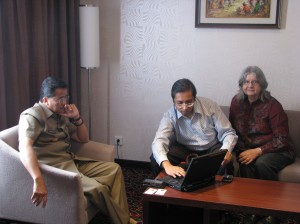
Governor Teras Narang of the province of Kalimantan Tengah listening to presentation
Shortly after my arrival in Jakarta I was told (in typical local fashion) that we had an appointment to meet with the Governor of our province, Kalimantan Tengah (Central Indonesian Boneo) in two days’ time. The appointment was at one o’clock in a suite at a hotel in Palangka Raya, the provincial capital, where the Governor was attending a conference.
Ms. Renie and I, along with two others in our group, took the early morning Garuda flight from Jakarta to Palangka Raya. I had to get up at some ungodly hour like 4 am in order to get to the airport at least one hour before the flight. To my surprise, the drive to the airport ,which normally takes at least one and a half hours under the normal conditions of Jakarta traffic, took about 40 minutes in the early morning darkness! “I had no idea that the airport was so close, “I told the taxi driver.
Our main purpose in meeting the Governor was to try to convince him to cancel some problematical palm oil plantation concessions in the Seruyan Regency on the eastern side of Tanjung Puting National Park. The Forestry Minister (I don’t care what anyone says; I have to compliment him on this one case!) has refused to sign off on these concessions. The Regent of the Seruyan region, who had initially recommended them several years ago, recently changed his mind and wrote a letter to the Minister of Forestry cancelling his recommendation. We were trying to persuade the Governor to do the same.
The four of us, including Ms. Renie and myself, were met in Palangka Raya by two state legislators who took us to a local Chinese restaurant for an early lunch. In Indonesia it is still possible to take drinking water or other fluids on board domestic flights. This proved a boon as for some reason, despite several entreaties by several members of our party, myself included, the waiter repeatedly forgot to bring me any water or the fruit juice I had ordered. I would have been reduced to drinking from other people’s glasses had I not been able to pull out my bottled water. Sometimes it is best to be prepared.
The local freshwater fish, fried to a crisp, and the river prawns were delicious. But, sitting in the private dining room off the main restaurant, I noticed that one member of our party was practically dancing with his legs as he sat at the table. It turned out he had a gigantic cockroach go up under his pant leg. He shook the cockroach out and it darted under the table, heading in my direction. Suddenly I felt hard little legs going up my leg under my pants! I grabbed the creature who was now in the middle of my left thigh under my pant leg and squeezed as hard as I could with my fingers. Then I shook my left leg and a smashed, decapitated giant cockroach fell out onto the floor. I’ve been in Kalimantan too long, I thought. The incident wasn’t even worthy of comment to anyone at the table. However, I kept a very watchful eye on the floor for further cockroaches as I ate my meal. My water and freshly squeezed fruit juice finally arrived just as we were getting up to leave.
We arrived at the appointment an hour early. This appointment was so important that we didn’t dare risk being one minute late.
The hotel had just opened days ago and was gleaming. The lobby was crowded with officials attending the conference on improving infrastructure in the provice. I met the Governor’s older brother who was the head of the provincial legislature. He was a Dayak in his late sixties. (The Dayaks are the aboriginal people of Borneo). The irises of his brown eyes were surprisingly rimmed with blue around the brown. I told him I had never seen such a thing before. He laughed, leaned towards me, and said that it was indicative of his European heritage. I think he was joking but I couldn’t be certain!
After the older brother left to join a conference session, someone said “That family are the Kennedys of Kalimantan Tengah.” When I looked confused, he explained that in addition to the Governor, the older brother who was the head of the provincial legislature, and nephews who were provincial legislators, there were other members of the family who were politicians or in government service.
The Governor saw us ten minutes late. The meeting which was scheduled for one hour lasted about one hour and two minutes. The Governor, a thoughtful man behind glasses, listened very attentively to our presentation concerning the forest in the Seruyan area. The Governor asked several questions but the most interesting question had to do with the Regent of the Seruyan area. “Why”, asked the Governor “had the Regent from the Seruyan changed his mind about the palm oil concessions and cancel his recommendation for them?”
We explained that the situation in the world had changed. The Seruyan Regent realized that there was now a possibility that intact forests could be worth more for the voluntary carbon trade than cut down and cleared for palm oil.
Could the Governor, I asked, provide a letter that supported the cancellation of the palm oil concessions in the Seruyan area. The Governor thought for a few seconds and said that he would have to consult with his advisors and other government officials before he could issue such a letter. He seemed sincere and pleasant. We were told that he was absolutely “clean” but gave away palm oil concessions as a reward for political supporters. He could not be bought but did reward his loyalists. How different is that from politicians anywhere in the world?
The next morning we left Palangka Raya, returning to Jakarta in the early afternoon. We didn’t know whether our mission with the Governor had succeeded or failed. Ms. Renie and I discussed it briefly but decided that only time would tell.
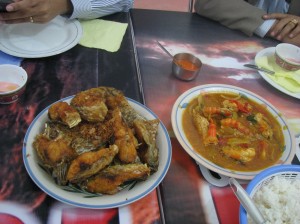
Delicious food in Palangka Raya: Fried river fish and prawns

With the chairperson of the provincial legislature, the Governor's older brother

View of Palangka Raya on a rainy day from fourth floor of hotel
Posted in 1 | 8 Comments »
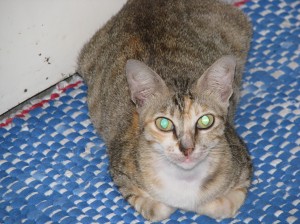
"Siamese", the cat with the long straight tail (unusual in Indonesia) who showed up at the OFI office and took up occasional residence
Jakarta, like most cities in developing countries, is very much a city of contrasts with mansions in Pondok Indah rivalling those in Beverly Hills, California, and slums in south Jakarta reminiscent of Calcutta. It is also noisey, gritty, smoggy, and sweaty. But it still has some of the nicest people in the world. You just have to engage them.
The OFI office is in a very typical part of Jakarta, a middle-middle class area with very narrow streets (just wide enough for two small cars to squeeze by each other if both drivers are very careful). Each household has a car. There are two parks closeby, one small and the other quite large, where children are allowed to play and people walk and jog.
Closeby is a market. The market sells fish and chicken and there are cats galore. The Indonesian attitude towards cats is remarkable. They are tolerated and almost treated as if semi-sacred. Mohommed himself respected cats. It is written that a cat was sleeping on his prayer rug. Rather than disturbing the cat Mohommed carefully cut around the cat to move his rug so that he could pray. However, even in the non-Moslem areas of Indonesia, cats are given much respect and never killed. If an Indonesian kills a cat by accident with a car, it is a major trauma. People have been known to sell their cars immediately after the car hit a cat. I know an Indonesian who blamed all his subsequent misfortune to having accidentally run over a cat in the dark.
Most cats in Indonesia have short, crooked tails. Visitors ask if someone cut their tails off but it is not so. The short tails come from genetics. Our cat whom we named “Siamese” because she bears a superficial (and possibly genetic) resemblence to Siamese cats in her elegance, large eyes, and screeching vocalizations, started appearing at the OFI office. Eventually we let her in and started giving her left-over rice and tidbits. Her visits became more frequent. Now she comes daily and brings her offpsring with her. I have tried to get her spayed but she is either perpetually pregnant or suckling her kitten(s).
Ms. Renie and Mr. Yandi who work at the OFI office say that a cat’s life near an Indonesian local market is a good one. “Siamese” tends to have one kitten at a time, anyways, they say so there won’t be a cat overpopulation any time soon. Her last litter consisted of a remarkably beautiful orange-colored kitten that has no stripes of any kind. I have noticed that the rats have disappeared around the office. We are fortunate to have this elegant cat and her brood visiting and sometimes even staying at our OFI office in Jakarta.

Government and other buildings in Jakarta

Interesting building in downtown Jakarta

A campaign banner for the current President of Indonesia on a building next to McDonalds

Buildings with flags from the party of Sukarno's daughter, Ibu Megawati, who was once president and is running again for the office.
Did I not mention that a presidential campaign is going on and the three major candidates for president, which include the current president, a past president, and the current vice-president, are actually participating in official debates? The polls indicate the current president will win but probably not by a 50% majority which means that there will be a run-off election.

A girl in front of a street corner stall in Jakarta selling cigarettes, candy, and crackers. There are tens of thousands, if not more, of such street stalls in Jakarta.

Graffitti on a wall in Jakarta. The six-pointed star was commonly found on Jakarta's walls. I asked what it meant and someone told me it was the insignia of a street gang while someone else told me it was a cigarette brand.

Typical entrance to typical Jakarta alley
Posted in 1 | 2 Comments »
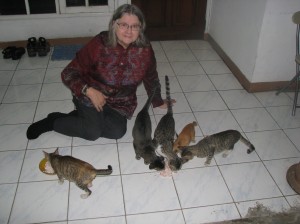
Dr. Birute at the OFI Jakarta office with the mother cat and her offspring who adopted us

Ms. Renie, office manager OFI Jakarta, and Mr. Martin from OCSP, after a meeting in Jakarta

Mr. Edy Hendras, Indonesian conservationist extraordinaire, editing OFI's Indonesian language newsletter
It’s great to be back in Jakarta, a city that many foreigners avoid. It is also called “The Big Durian” and the pollution does sometimes stink. Jakarta is Indonesia’s capital, largest city, and probably its most dynamic urban area. It has at least ten million people and is one of the largest cities in the world, number 12, at last count.
Jakarta is also the city of dreams. This is where Java’s rural poor come to earn a living, students come to get an education, and entrepeneurs to start or expand their businesses. This is where people come to make their dreams come true.
Jakarta is the center of government power for the unitary state of Indonesia. With regional autonomy, the provinces and regions gained some power but in the end, much depends on Jakarta. About five or so years ago, OFI decided to establish an office in Jakarta. We are a small foundation so it was a risk for us financially. But it was well worth it. Previously, with our one office in Pangkalan Bun, we were relatively isolated from the decision-makers both in Jakarta and the provincial capital of Palangka Raya. Under Ms. Renie’s guidance, the OFI office improved our communication and relations with government agencies. Even now communication with Pangkalan Bun in Central Indonesian Borneo (Kalimantan Tengah) can be a problem.
In particular, there is a tendency in Indonesia to call meetings a day or so before they actually take place. It’s helpful to have someone in Jakarta who is dedicated to communications and gets told about the meeting as soon as possible. Otherwise, in Pangkalan Bun we get notified of the meeting days after it has occurred!
Ms. Renie was my first female Indonesian student and did her undergraduate honors thesis on orangutan parasites in Kalimantan. She went on to study a wild orangutan population in Sumatra. This served as the basis of her Master’s degree in ecology at the University of Indonesia. In some ways, she is a pioneer, having studied the southernmost of all Sumatran orangutan populations. One of her life ambitions was to be a working primatologist and she is grateful to OFI and its supporters for allowing her to fulfill this dream. For her, Jakarta is where her dream was fulfilled – in its fullest.
Mr. Edy Hendras is another one of my former students from Universitas Nasional, Jakarta. He, too, found a successful career in conservation. He works primarily in conservation and environmental education, having set up conservation education and training programs throughout Indonesia. I sometimes call him on his cell phone and when he answers, he’s often in the Indonesian portion of New Guinea or in Sulawesi working with local people, training them in such practical enterprises as composting or making gas fuel for cooking stoves from the manure of farm animals. When he worked for OFI in Pangkalan Bun, he set up field training trips for hundreds of local high school students where they went into the wilderness for several days at a time and learned about conservation and nature. But he has long been based in the Jakarta area and Jakarta is where his dream to work in conservation was fulfilled.
Jakarta also helped my dream of studying wild orangutans come true 38 years ago. This is where I received the first permits to do my orangutan study. I still come to Jakarta several times a year: to buy supplies, to attend meetings, and to catch international flights in and out of Indonesia.
Thirty-eight years ago I heartily disliked Jakarta. It was a noisy, polluted city where you could barely breathe and where you could hardly hear yourself think because the roar of traffic was so loud. Air quality was dismal. My eyes watered. I had a constant headache. I coughed incessantly. Traffic was insufferable. Drivers honked their horns seemingly non-stop. Bejaks, bicycle cabs, were everywhere and obstructed traffic.
In time the municipal government banned the bejaks. I think they should have banned the motorized traffic! What an avant-garde city Jakarta would have been then! They also cleaned up the air quality somewhat and instituted “busways” so that commuters could get around Jakarta remarkably quickly with high speed (by Jakarta standards) buses on dedicated lanes.
During the first twenty years of my stay in Indonesia one of the great things about coming to Jakarta was that I could actually make phone calls to my family back in Los Angeles. It took some effort but it was do-able. I could taste ice cream and western food such as spaghetti. Over the years I have lost my taste for ice cream but not spaghetti. But we can now get a version of spaghetti with tomato sauce even in Pangkalan Bun. About seven years ago we even got cell phone service in Pangkalan Bun!
I like Jakarta better now than I did when I first arrived. I think it’s because Jakarta changed and I changed. I learned Indonesian and became used to the rhythmn of life common here.
Jakarta has changed in a number of ways inconceivable forty years ago. It now has shopping malls to rival New York and Singapore. All the prestige brands are here. My favourite shopping malls are in Jakarta. I cannot even afford to think about the three thousand dollar bags and three hundred thousand dollar champagne diamond bracelets but I can browse, take a look, and move on, content that my meagre cash assets are going to save species and individual animals, a pleasure that no mere material trinket will ever provide. I can buy office and field supplies, most types of food, and even books and magazines in the English language, all impossible to do when I first arrived in 1971.
Another marked change is the dress of women. Forty years ago women wore Western clothing or a modified version of traditional Sundanese (West Java) or Javanese clothing. Now, increasingly, they wear Islamic head dresses and sometimes flowing robes. Once or twice, I have even noticed full facial veils on local women. In some places near Jakarta, a tipping point has been reached with signs from the local government saying “Respectable women wear head coverings.”
Clearly, a dichotomy has been reached with one part of Jakarta racing into the future and another striving to hold on or to find a comfort zone that perhaps is difficult to attain in this modern world.
I stayed in Jakarta one and a half weeks, attending government meetings, working on our Indonesian newsletter with Ms. Renie and Mr. Edy, buying watches and backpacks and other supplies for our field staff, and doing a variety of other tasks that needed to get done.
I spent much time (literally hours) in Jakarta’s notorious traffic (worse now than the traffic in Los Angeles or Bangkok) just trying to get from one appointment to the next. And dreaming, paradoxically, of the days when I could spend more time in Jakarta, enjoying it, instead of rushing through it, and of the days when I would spend none here at all.
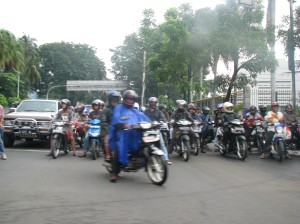
Jakarta's traffic is well-known for its hordes of motorcycles

Atypical Jakarta traffic - not so heavy. Notice the abundance of taxis.

Carrying a baby carrier on a motorcycle, the vehicle of choice for millions in Jakarta

Not a bare head to be seen! Presidential campaign banner for candidates J. Kalla, current vice-president, and Wiranto, Kalla's vice-presidental choice, with their respective wives shows all wearing head-gear, the women head scarves and the men mosque-hats.
Posted in 1 | 1 Comment »

OFI buying forest from happy local man
Mr. Freddy, a local businessperson from the province of Kalimantan Tengah, flew to Jakarta so that he could immediately receive the funds for 20 ha. of forest that he agreed to sell OFI. Otherwise, the forest would have been cleared for palm oil and lost forever to a relic population of about 50 – 100 wild orangutans just barely hanging on by the skin of their teeth in a mixed area of peatswamp forest, dry ground forest and cleared land near Pangkalan Bun.
This forest will be ours in perpetuity. Twenty hectares (approximately 50 acres) may not seem like much but for the birds and mammals who live there, it will be like a universe saved!
Mr. Freddy charged the same price for the forest that he ws planning to charge a palm oil concession but he admits that he feels better about being able to save the forest!
Posted in 1 | 2 Comments »